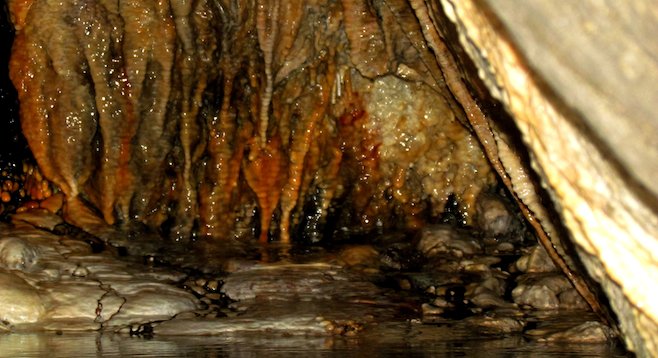 Facebook
Facebook
 X
X
 Instagram
Instagram
 TikTok
TikTok
 Youtube
Youtube

Weathered from a 75-million-year-old sandstone cliff in La Jolla are seven sister caves. Like many other seaside caverns, these, too, have been used by pirates. Only the cargo they smuggled was human.
California’s eight-year-gold rush enabled the remote Western territory to blossom into full-fledged statehood with half a million new residents, many of whom had emigrated from Asia. After the mines closed, the Transcontinental Railroad race lured tens of thousands “Celestials” from China, so named for their diligent work ethic and controlled, if not serene, mode of behavior.
But then again, they were up against the surly, hard-drinking, fast-fisted Irish immigrants swinging hammers for the Central Pacific Railroad.
It wasn’t long before more than 80 percent of the workforce was Asian. In 1868 alone, more than 12,000 Asian workers, predominantly men, had come across the Pacific by the boatload to tie rails. Rising prejudice led to the adoption of exclusionary acts that began to limit immigration from the Far East. These bans, not surprisingly, spawned the first commercial smuggling of contraband human cargo in the U.S.
The seven caves in La Jolla provided shelter for turn-of-the-century profiteering pirates. San Diego offered a warmer, more hospitable climate for the newcomers than the hostile northern cities, both literally and figuratively. Teaching “Americanization classes,” the Chinese Mission School served as a safe haven for this discriminated population. The California Southern Railroad hired large numbers of Chinese workers and the National Historic Landmark Hotel del Coronado was built largely by Asians.
Only one of the caves is accessible by land. Sunny Jim Cave can be accessed for a $4 admission fee. The algae-cloaked 145 stairs lead through a colorful, well-lit, hand-carved tunnel located behind the back door of the historic La Jolla Cave Store (formerly called the La Jolla Cave and Curio Shop). Sunny Jim was named by Frank Baum, author of the Wizard of Oz, because the opening resembles the silhouette of a 1920s British cereal box character and military mascot.
Upon descent, visitors are restricted to a planked walkway that juts out over the incoming waves. The dimness of the cave makes Sunny Jim’s face appear in vivid contrast to the subtropical cerulean skies outside. There he is, pointed nose and hat, facing westward, out towards sea. A strong flashlight will reveal stalagmites dripping into a small pool to the right of the base of the stairwell.
Closing my eyes, I listened. To the waves, to the water behind me dripping, to the pigeons nesting on the ledge of Sunny’s nose, to the scurrying in the shadows. To the rhythmic breathing of time through the multicolored stone walls. It’s easy to imagine the queued men squatting away from the light of day, arms wrapped around knees, whispering to prevent echoes, shivering in anticipation of a moonless landfall.
For me it is, at any rate – but then again, I’m known to have an active imagination.


Weathered from a 75-million-year-old sandstone cliff in La Jolla are seven sister caves. Like many other seaside caverns, these, too, have been used by pirates. Only the cargo they smuggled was human.
California’s eight-year-gold rush enabled the remote Western territory to blossom into full-fledged statehood with half a million new residents, many of whom had emigrated from Asia. After the mines closed, the Transcontinental Railroad race lured tens of thousands “Celestials” from China, so named for their diligent work ethic and controlled, if not serene, mode of behavior.
But then again, they were up against the surly, hard-drinking, fast-fisted Irish immigrants swinging hammers for the Central Pacific Railroad.
It wasn’t long before more than 80 percent of the workforce was Asian. In 1868 alone, more than 12,000 Asian workers, predominantly men, had come across the Pacific by the boatload to tie rails. Rising prejudice led to the adoption of exclusionary acts that began to limit immigration from the Far East. These bans, not surprisingly, spawned the first commercial smuggling of contraband human cargo in the U.S.
The seven caves in La Jolla provided shelter for turn-of-the-century profiteering pirates. San Diego offered a warmer, more hospitable climate for the newcomers than the hostile northern cities, both literally and figuratively. Teaching “Americanization classes,” the Chinese Mission School served as a safe haven for this discriminated population. The California Southern Railroad hired large numbers of Chinese workers and the National Historic Landmark Hotel del Coronado was built largely by Asians.
Only one of the caves is accessible by land. Sunny Jim Cave can be accessed for a $4 admission fee. The algae-cloaked 145 stairs lead through a colorful, well-lit, hand-carved tunnel located behind the back door of the historic La Jolla Cave Store (formerly called the La Jolla Cave and Curio Shop). Sunny Jim was named by Frank Baum, author of the Wizard of Oz, because the opening resembles the silhouette of a 1920s British cereal box character and military mascot.
Upon descent, visitors are restricted to a planked walkway that juts out over the incoming waves. The dimness of the cave makes Sunny Jim’s face appear in vivid contrast to the subtropical cerulean skies outside. There he is, pointed nose and hat, facing westward, out towards sea. A strong flashlight will reveal stalagmites dripping into a small pool to the right of the base of the stairwell.
Closing my eyes, I listened. To the waves, to the water behind me dripping, to the pigeons nesting on the ledge of Sunny’s nose, to the scurrying in the shadows. To the rhythmic breathing of time through the multicolored stone walls. It’s easy to imagine the queued men squatting away from the light of day, arms wrapped around knees, whispering to prevent echoes, shivering in anticipation of a moonless landfall.
For me it is, at any rate – but then again, I’m known to have an active imagination.
Comments